On day 5 of our safari we left Serena Lodge overlooking the Rift Valley near Lake Manyara and started toward Ngorongoro Crater. The drive was a long one and we broke it up by stopping mid-morning at the Endoro Gate entrance to the Ngorongoro Conservation area. There Barbara and I, accompanied by a very tall Park guide, hiked in mountainous terrain for several hours to see the “Elephant Caves” and the Endoro Water Falls. We initially assumed our guide must be a member of the Maasai tribe because of his extreme height, but he was not; he was a member of the Sukuma tribe that occupies the western part of Tanzania near Lake Victoria. They constitute the largest of the 126 tribes of Tanzania, numbering about 10,000,000 out of the total population of about 40,000,000.
As an aside, most of the 120 or so tribes are members of the extensive central and southern Africa Bantu family. The nomadic, cattle-owning warrior-tribe, Maasai, are not part of the Bantu family, and there remains a sharp local distinction between them and most other Tanzanians. Until recently in their histories, each of the 126 tribes spoke a different, though often somewhat related language with Bantu roots. These many languages are gradually being displaced by a common Bantu lingua franca, Seswahili, which has gained national acceptance, and international as well, as there are a number of Bantu-dominated societies in other African countries. Almost all of the Tanzanians we encountered also speak English, many quite well, others rudimentary. Raymond is a member of the prominent Chagga tribe generally located along the eastern coast of Tanzania and inland from there. They are noted for their entrepreneurial attitudes, and certainly that was evident from our exposure to the many guides, most of whom are Chagga. Raymond studied English (British style) in elementary school, and at the secondary level all classes are taught in English rather than in Swahili.
The hike to the Elephant Caves was longer, hotter, and more strenuous than we anticipated. We finally arrived after a couple of hours on the trail. It seemed like more! We saw a few birds along the trail, but nothing very exciting. Our guide was aware of our interest, however, and made a good effort to point out those few birds that could be seen along the tree-shrouded trail. He knew a lot about the local plants and birds, including the scientific names. He would love to go to college and become a biologist, but at his age, 30, that will be tough.
The Elephant Caves were not impressive.
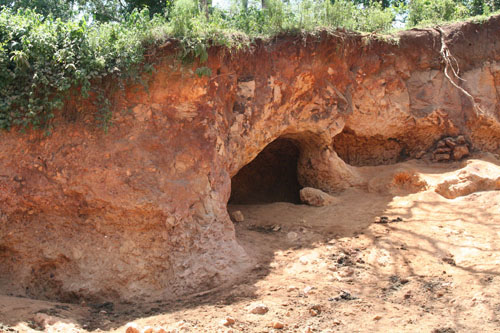
The clay along the river in this area contains minerals that elephants crave. For centuries they have come here to dig up the clay and eat it. A few years ago, as a result of exceptionally heavy rains, the wall of the caves facing the river collapsed, so that the cave is now quite small. The elephants still come and eat away at the wall. Maybe someday they will create another good-sized cave. We had taken quite a long time to hike up to the cave. Our guide suggested that we might want to skip the Endoro Water Falls because the season had been very dry and there was very little water in the river. We readily agreed.
After a quick box lunch at the parking lot of Endoro Gate, we headed off for our lodging for the night, near Ngorongoro Crater. Originally we had been tentatively booked into the Sopa Lodge, which is an upscale lodge on the grounds of the Ngorongoro Conservation area, but it was over-booked. Our back-up was an out-of-park facility known as the Coffee Farm. We were actually quite pleased with this facility. The units are strung out along the edge of the coffee groves. They are very old, drab and unattractive from the outside, but spacious and comfortable inside. We enjoyed good food, beer, and great coffee at the large and comfortable central lodge. We also enjoyed some decent birding on the grounds including a White-browed Robin-Chat.

One of the culinary surprises was the quality of the bacon throughout our trip. At every stop we were able to select bacon for breakfast and it was invariably excellent. It is cut like Canadian bacon, but thin, and fried like American bacon. There is very little fat in it, yet it is tasty. The other delight was the fruit, which was plentiful and flavorful. Passion fruit, water melon and papaya were especially good. Chicken is a staple, and we had a lot of fried chicken in our packed lunch boxes.
After breakfast on Day 6, we drove to the Crater. Maasai still reside around the Crater and tend their herds.
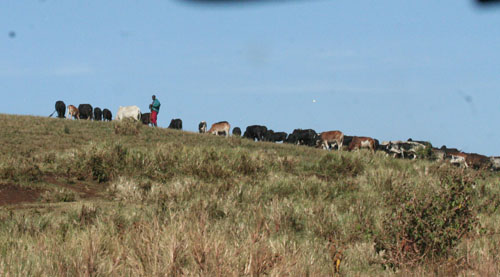
The Crater itself is immense. It is its own environment. As we descended to the floor of the Crater we saw hawks of various kinds, many Abdim Storks,
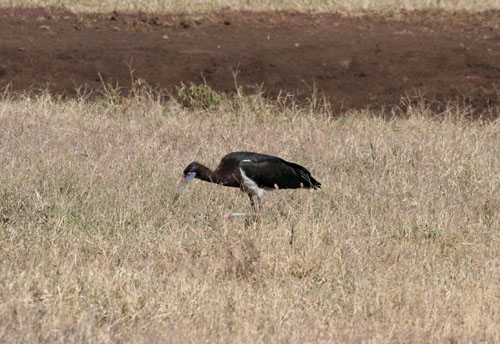
grassland birds, including Red-crowned and Rufous Naped Larks, and Great Bustards.
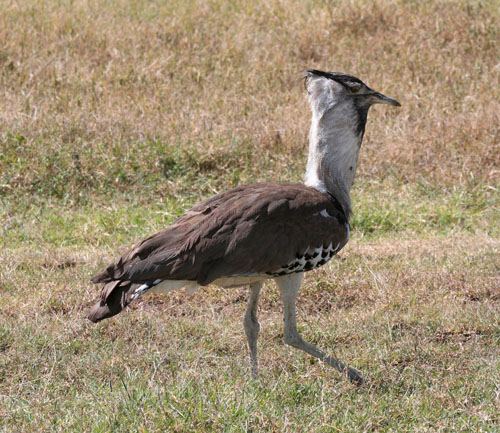
There were a number of Black Kites and water birds near the relatively small ponds found throughout the Crater.
We knew that the Crater was our best chance of finding the second of our top two targets for the trip, Rhinoceros. Mid-morning we were thrilled to see our first Rhino, grazing on the short grass of the Crater floor, but at a considerable distance from us.

The Rhinos are greatly threatened by poaching for the Asian aphrodisiac trade. The prices paid for a dead Rhino are fantastic, such as $250,000 for one, primarily just for the powder that comes from its horn, supposedly a great aphrodisiac. As a result there is a constant warfare, and I mean warfare, between poachers and wardens wherever Rhinos still exist. About 10 years ago, the population at Ngorongoro, one of the few places where they still live in the wild, was reduced to 8 individuals. Stepped up protection has resulted in an increase to 15. The rate of progress is not great because the rate of reproduction among Rhinos is very slow. The females reach baby-bearing age at between 5 and 7 years, they produce one baby at a time, and they don’t have their next one for another 5-7 years.
After having our box lunches at a picnic area near a pond, we resumed our drive through the Crater. We spotted a Wildebeest mother giving birth. The baby was up and running within minutes. They do not want to be left behind, because that spells doom in the heavily predated plains of Africa. The instinct to survive has created amazing physical adaptations.
A few Golden and Black-backed Jackals were out looking for food. The Spotted Hyenas were jogging along among the zebras and wildebeests.
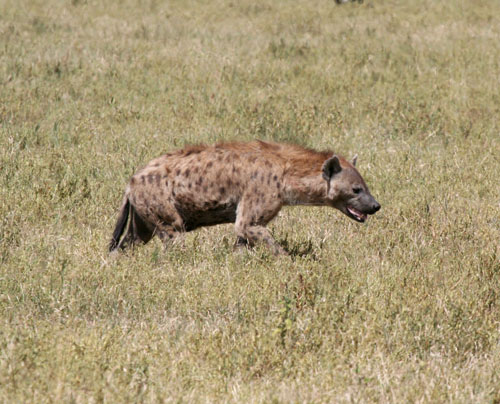
We didn’t pay much attention to the herds of Cape Buffalo.
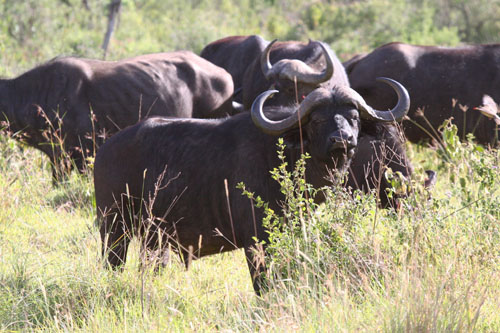
We assumed we would see many more in the days to come. As it turned out, we saw very few after we left the Crater.
We did see two more Rhinos just before we exited the Crater. They were lounging in the shade of a tree quite a long distance from the road. We returned to the Coffee Farm and enjoyed a relaxing evening.
